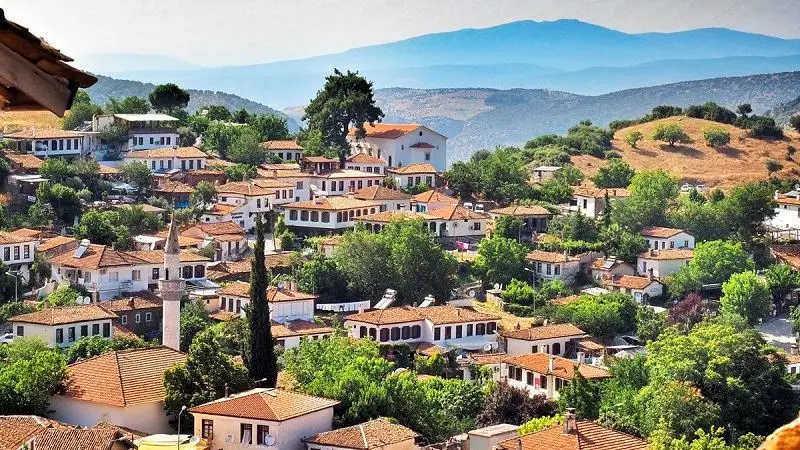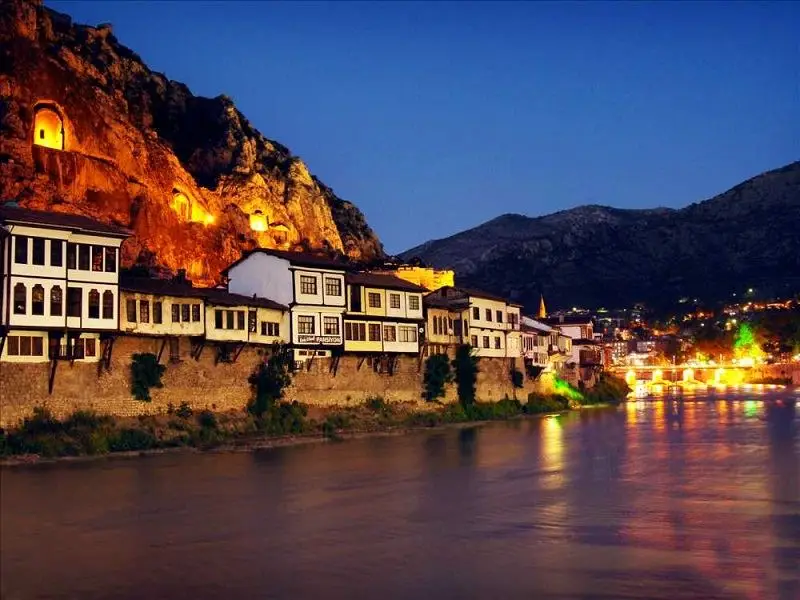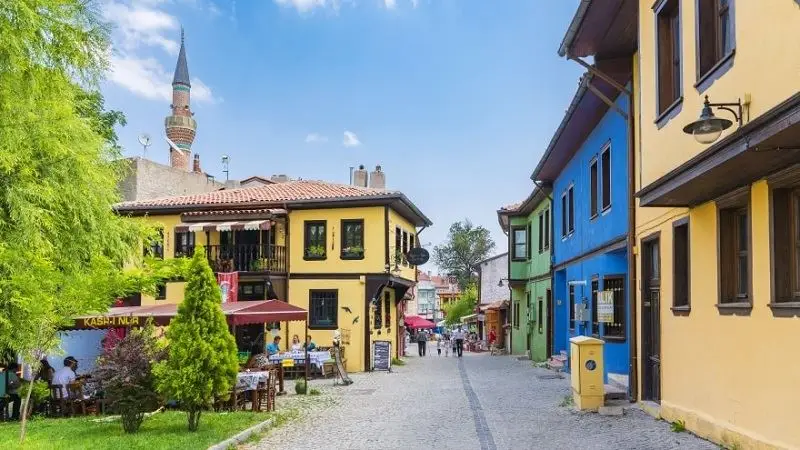Historical Turkish Villages

Towns in Turkey That Tempt with Their Ottoman Structures

The built environment tells a story about the values, aesthetic preferences, and social mores of a given era through its architecture and the spaces it occupies. In this way, they can be used as a museological source to show a picture of a culture in which the way things are made is a way to keep and share rules about time.
The goal of this article is to tell you about some unique Ottoman artifacts that have stood the test of time, linked the past to the present, and sent us a very important message.
Akseki-Ibradi, Antalya

The first place we’re going isn’t a specific location but rather a stretch of land that includes Antalya’s Ibradi and Akseki districts. The region was once a key stop along the Silk Road, and remnants of that era can still be found there. The area is on the Taurus Plains and has a lot of beautiful natural sights like open plateaus, roaming herds of wild horses, and unusual geological formations like the Altinbesik cave.
In Akseki and Bradi homes, stones are laid directly on the bond beam structure; no binder materials like cement or grout are used in the building process. The locals have dubbed these homes “buttoned houses,” dugmeli evler, because of the protruding wooden ends that can be seen from the street.
The distance between Akseki and Ibradi is only 26 kilometers. Some of the region’s most impressive examples of these dwellings can be found in Sarihacilar village in Akseki, Ormana village in Bradi, and Urunlu village in Bradi; additionally, some of these homes are available for overnight stays, and if you happen to be in the area in August, you can participate in the Grape Festival, which has been held in the Ormana village for the better part of a millennium!
Cumalikizik, Bursa

One of the earliest Ottoman settlements in Bursa, their first capital, was at Cumalikizik. This means that the average age of a Cumalikizik home is close to 700 years. 270 homes date back to the early Ottoman eras; 180 of them are currently inhabited, while the rest are either abandoned or undergoing restoration.
Almost no development has taken place in Cumalikizik, so visitors can see how the town’s market continues to serve as a place for time-honored customs and interactions. The town’s rich heritage has earned it a spot on UNESCO’s World Heritage list.
Visit this site if you’re interested in seeing what everyday life was like at the beginning of one of the world’s greatest empires.
Amasya’s Yaliboyu House

Elegant relics of the late Ottoman era, the Yaliboyu houses of Amasya are best seen along the Yesilirmak riverfront on Hazeranlar Street in the Hatuniye neighborhood in the city’s downtown. Attached homes are common, and their interiors are typically designed to separate the living quarters into haremlik and selamlik areas for the genders. Because of the high risk of fire in these predominantly wooden homes, some of them feature an indoor swimming pool. Typical of Turkish architecture, these residences feature a courtyard and garden on the ground floor and a cumba, a jetty that opens up the upper floor, to accommodate growing families.
Houses like these along the river in Amasya are among the city’s most photogenic attractions, and visitors can even stay in one.
Karabuk’s Safranbolu Town

Between the 17th and 18th centuries, Safranbolu’s traditional Turkish architecture reached its pinnacle, and today the city is home to 2,000 such buildings, 800 of which are designated as historic landmarks. These houses are distinct from the Amasya homes in that they are not joined together, but they share the same concern for the equal distribution of sunlight among all of the neighborhood’s dwellings.
Some of the homes here are built similarly, with interior pools strategically placed to ward off flames. Safranbolu is a tourist’s dream, with its stone-paved streets, beautiful architecture, and bustling city center, where many of the locals’ long-held traditions have been kept alive.
Eskisehir’s Odunpazari District

Odunpazari, on the southern hills of Eskisehir, is home to attractive houses that are attached and are built in the same style as those in Amasya, but which are painted in brighter and more vivid colors. With a winding street, harmoniously blended white walls and brown beams, some sprinkles of other pastel colors here and there, and the fabric of a total city space with traditional housing, mosques, complexes, caravansaries, fountains, and old lodgings, this neighborhood is a prime example of traditional Turkish Anatolian architecture and is thus nationally and internationally protected as a “Historical and Urban Site.” In Odunpazari, you’ll feel as if you’ve stumbled onto the set of a fantasy film.
Ankara’s Hamamonu District

Hamamonu, located in Ankara’s Altindag neighborhood, is a historic neighborhood with a rich past. In the spirit of Amasya and Odunpazari, we will be touring a collection of homes that were built in the 19th century. Mehmet Akif Ersoy, the poet who penned the Turkish national anthem, penned it right here in the park that bears his name. You can also drop by his Hamamonu residence.
Tirilye, Bursa

Trilye, a once-thriving Rûmian town that flourished under the Ottomans, is perched on the sides of a valley, with olive groves on its interior and the stunning blue of the Marmara Sea on its exterior. The town’s signature olive farming, winemaking, and silk production are all still going strong, and it features some stunning examples of Eastern Roman architecture. The town welcomes guests with its verdant landscapes, historic landmarks, and rooted culture.
Mudurnu, Bolu

Because of its significance in preserving important examples of Turkish civil architecture, Mudurnu, like other national landmarks, is legally recognized as a “Protected Urban Site.” Mudurnu is perched on the side of a hill, so naturally, the homes there are elevated. More than a hundred homes, mosques, fountains, and hammams are registered under the law on conservation in the area, and they all offer fascinating insights into daily life during the Ottoman era.
Kula, Manisa

The Kula homes, another example of Turkish architecture from the 19th century, dominate the landscape with their unique style. All of these homes have private courtyards that are separated from the street by a wall. The windows in the living rooms that face the courtyard are sometimes left open, while those that face the street show how the Ottomans treated their private and public spaces.
Goynuk, Bolu

While the majority of Mudurnu’s homes were built in the 20th century, the majority of Goynuk’s were built in the same era. Goynuk was added to the list of Cittaslow cities in 2017. The beautiful natural setting in which you will spend your time in Goynuk is guaranteed to restore your spirits and melt away your cares.
Experience the rich history and culture of these towns while strolling at a leisurely pace. They welcome you with open arms and promise to make you feel at home as you travel back in time.
Luxury Tours of Turkey
Ι Luxury Turkey Tour Package Ι Luxury Istanbul and Cappadocia Tour Ι Luxury Cappadocia Tour from Istanbul Ι Luxury Discover Turkey Tour Package Ι Luxury Istanbul and Ephesus Tour Ι Luxury Istanbul and Bodrum Tour Ι Luxury Istanbul Ephesus Pamukkale Tour Ι Luxury Discover Turkey Tour Ι Luxury Istanbul Tour Package Ι Luxury Discover Istanbul Tour Ι Luxury Istanbul and Antalya Tour Ι Luxury Istanbul Tour Ι
Luxury Turkey Travel Services
Ι Luxury Turkey Travel Services Ι Luxury Airport Transfer in Turkey Ι Luxury Istanbul Chauffeured Car Service Ι Tour Guide in Turkey Ι Istanbul Helicopter Tour Service Ι Luxury Istanbul Yacht and Charter Service Ι Turkey Private Jet Flight Service Ι
Luxury Daily Turkey Tours
Ι Luxury Daily Turkey Tours Ι Luxury Istanbul Old City Tour Ι Luxury Istanbul Bosphorus Cruise Ι Luxury Princes Island Tour Ι Luxury Self Guided Tour Istanbul Ι Luxury Cappadocia Tour from Istanbul Ι Luxury Ephesus Tour from Istanbul Ι
